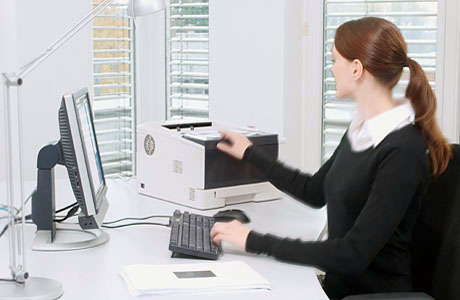
On the face of it, choosing a printer for your business seems like it would be a relatively easy decision. But, there are several different types of printers, and depending on your exact needs and budget, one option may be particularly better than another. You actually want to give some careful thought to this decision to make sure you find the one that best meets the needs of your business. Here are just a few helpful hints.
The Cheapest Printer is not Necessarily the Most Affordable
Before you make a beeline to the cheapest printer that will meet your needs, know this may end up costing you more in the long-run. The cheaper the printer, the more expensive the replacement ink or toner tends to be—this is how vendors keep their profits up. If you don’t print a lot, this scenario may work just fine. So, consider your printing needs, and price ink and toner as part of your decision-making process.
According to printing solution provider Axis Business Technologies, looking at the total cost of ownership is key to choosing the right printer. It notes that color laser printers, over their lifetime, can reduce printing costs by a whopping 70 percent.

Office Size and Volume
You must carefully consider the size of your office and the volume you are printing. Is it just a few sheets a day, dozens or hundreds? How many people will be using the machine? If you will be the only person using it, a personal ink jet or laser printer will suffice if you are not printing more than a dozen pages a day. For a printer in use by many people, Ethernet networkability is a must. Wireless can be good too for smaller groups, but reliability and speed vary.
Track your printing needs for a few days, and look for printers whose standard input tray surpasses your average daily volume by a smaller or greater amount, depending on how much you want to refill the tray. You also want to check the specified monthly duty cycle, and stay well below this number. This figure is representative of maximum stress on the machine, not what it can handle comfortably on a regular basis.
Speed Needs
How quickly do you need the printer to work? You anticipate print volume will be helpful in determining processing power, engine-speed and amount of memory. For the average office, a speed of 20 to 40 pages per minute is usually sufficient. Engine speed specifications are helpful but should not be taken at their absolute word as they may not reflect your typical printing patterns. This information is helpful though for gauging how a printer can perform under optimal conditions.
Single or Multi-Function?
If you are just planning to print documents, the answer is obvious-single function. But, you might consider a multi-function if you want to do things like digitize paper files, share documents, make photocopies or create electronic documents or images to be save or emailed. If you have a lot of people in the office doing all their printing, scanning and what have you, on one machine, that could overwhelm the machine and make for a more frustrating office experience. So, you might consider other options, such as having a dedicated scanner, for instance.







